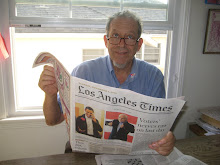HEBREW BOOKS
They’re selling off a bunch of Hebrew books
From Paris, Leiden, Izmir and Bombay.
Bibliophiles all cast their tenterhooks
into this heritage, but few can pay
the price demanded by the vendor. Did
I mention some of them come from Cremona,
some from Calcutta and Valladolid?
We try to guess who was the owner,
perhaps an old Jew in Jerusalem,
or Alexandria, perhaps Baghdad,
for whom possession of this precious gem
cost so much money that his wife forbade
him ever to buy books like that again.
The miracle Gans called the printing press
made books available to many men
who use their purchases to buy noblesse.
Sometimes these books fell to a gentile hand
and, rudely misinterpreted, were burned,
but many that weren’t criticized or banned
taught gentiles knowledge that the Jews had learned.
Westminster Abbey, for example, owned
a copy of the Talmud Henry used,
divorcing Catherine so she could be dethroned––
of breaking Bible laws falsely accused.
Stored in collections, Hebrew books like these
provide a printed, graphic illustration
of Jewish life, their pages like a frieze
where biblioscribal soldiers of the nation
aren’t athletes, charioteers or fabled fighters
defeating their unfriendly foes in strife;
they are the Jewish readers for whom writers
provide the reading rationale of life.
Ed Rothstein (“A Lifetime’s Collection of Texts in Hebrew,” NYT, February 12, 2009) describes the collection of Jack Lunzer’s books that is to be sold at Sotheby’s on February 19th:
Is bibliophilia a religious impulse? You can’t walk into Sotheby’s exhibition space in Manhattan right now and not sense the devotion or be swept up in its passions and particularities. The 2,400-square-foot opening gallery is lined with shelves — 10 high — reaching to the ceiling, not packed tight, but with occasional books open to view. Each shelf is labeled, not with a subject, but with a city or town of origin: Amsterdam, Paris, Leiden, Izmir, Bombay, Cochin, Cremona, Jerusalem, Ferrara, Calcutta, Mantua, Shanghai, Alexandria, Baghdad and on and on. You can’t read these books or pluck them from the shelves. But you feel their presence as you explore, particularly in adjoining rooms where volumes are open inside cases for closer scrutiny. These 13,000 books and manuscripts were primarily collected by one man, Jack V. Lunzer, who was born in Antwerp in 1924, lives in London and made his fortune as a merchant of industrial diamonds. The collection’s geographical scale is matched by its temporal breadth, which extends over a millennium. But this endeavor is not just an exercise in bibliophilia. These are all books written in Hebrew or using Hebrew script, many of them rare or even unique. Most come from the earliest centuries of Hebrew printing in their places of origins and thus map out a history of the flourishing of Jewish communities around the world. The collection’s historical gaps and boundaries are also revealing because they often implicitly mark periods of decline, which, we learn elsewhere, often meant public conflagrations of copies of these very books or even exterminations of the communities themselves. The collection, named after the Italian town that Mr. Lunzer’s family has long been associated with, is known as the Valmadonna Trust Library. Sotheby’s has put it on sale as a single collection. Through next Thursday it is being handsomely displayed to the public, while luring the large institutional libraries and collectors who might be prepared to pay at least $40 million for what Sotheby’s, echoing scholars in the field, describes as “the finest private library of Hebrew books and manuscripts in the world.” There are extraordinary items on display here, including a Hebrew Bible handwritten in England in 1189 — the only dated Hebrew text from England before King Edward I expelled the Jews in 1290. In 1190, the Jewish community of York was massacred and its property, including many books and manuscripts, was looted and sold abroad, where this volume was discovered. There is also an exquisitely preserved edition of the Babylonian Talmud (1519-23) made by the Christian printer Daniel Bomberg in Venice, an edition created with the advice of a panel of scholars that codified many aspects of how the Talmud is displayed and printed. This set made its way into the collection of Westminster Abbey, where Mr. Lunzer saw it, covered with dust, perhaps untouched for centuries. He ultimately acquired it in a trade, offering a 900-year-old copy of the Abbey’s original Charter.
© 2009 Gershon Hepner 2/12/09
Thursday, February 12, 2009
Subscribe to:
Post Comments (Atom)


No comments:
Post a Comment